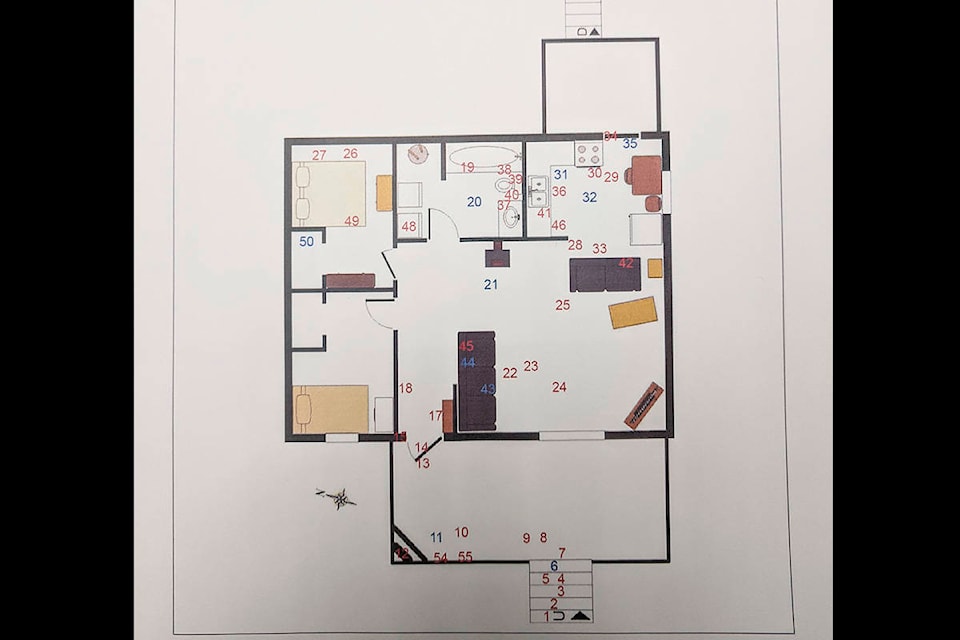A Whitehorse jury heard from a Yukon RCMP forensic identification specialist on Jan. 16 who helped examine and process Wilfred Charlie’s house in Carmacks after he was last seen in June 2017.
Cpl. Vanessa Philpott walked the court through nearly 60 photographs her supervisor, the late Sgt. Jim Giczi, took June 20, 2017, that showed suspected blood stains they found in Charlie’s living room, washroom, second bedroom, kitchen, doorways and front deck.
She was the third Crown witness to testify in the trial of Tyler Aaron Skookum, who stands charged with first-degree murder in relation to Charlie’s death.
Charlie, a 57-year-old who went by “Dickie,” was last seen near his home by the bank of the Yukon River on June 19, 2017. His body was found in the Yukon River near Fort Selkirk about two weeks later.
Skookum’s former co-accused, Mario Rueben Skookum, pleaded guilty to the lesser charge of manslaughter for his role in Charlie’s death in December. He’s expected to be called as a witness later in the trial.
Philpott testified that Charlie’s case was still considered a missing person investigation when she and Giczi were deployed to Carmacks the day after Charlie was last seen. Giczi had been briefed on the case the day on June 19, 2017, she said, and they left for Carmacks the next morning.
Giczi died in September 2019; Philpott answered the Crown’s questions about both their roles in the investigation, and the evidence they collected.
Philpott said she was serving as the Giczi’s secondary assisting forensic identification specialist and took videos both inside and outside Charlie’s home, created a scene sketch, helped in the search for evidence, collected evidence and did DNA swabs.
Giczi, meanwhile, placed evidence markers and took measurements and photos around the house, also returning to Carmacks two days later to photograph a tree stump on the river bank and take a bark sample.
Crown attorney Lauren Whyte played Philpott’s video for the jury, which showed the inside of Charlie’s house as well as the surrounding property, and also presented them with 57 photographs Giczi took.
Philpott confirmed that her video, filmed over the course of about three hours, showed the house as she and Giczi found it.
Asked to describe some of the images by Whyte, Philpott identified a number of red or dark-brown stains that she said were believed to be blood.
The stains ranged in size from small droplets on the stairs of Charlie’s front porch and smears on the front door and door frame to stains a few centimetres across on Charlie’s living room floor and couch. There were also sizable stains on the wood of the front deck (as well as a bloody tissue), on the underside of a pillow found on top of Charlie’s dryer, and on a mattress in the second bedroom but not the fitted sheet covering it.
A red, partial footwear print was also found on the washroom floor. Philpott said the print was never matched to a shoe.
Philpott testified that she swabbed any stains believed to be blood. The samples were then sent to the RCMP’s national forensic laboratory; a handful were confirmed to be blood.
Philpott said she also applied blood reagents on a number of surfaces, including the floors and a couch, to see if there was possibly any blood that had been cleaned up or otherwise not easily visible to the naked eye.
Giczi’s photos showed blue smearing — the colour the reagents turn when they come into contact with blood — across the washroom floor as well as the living room leading into the kitchen. A handful of blue stains were also photographed on the edge of a seat of one of the couches in the living room.
Responding to a question from Whyte, Philpott said she was not aware that a knife with Charlie’s blood on it was ever found, adding that she knew a knife was seized as evidence.
She also confirmed that she was called when Charlie’s body was found on July 5, 2017. Philpott testified that she travelled with two other RCMP officers by boat from Minto mine to Fort Selkirk, and that it took about 50 minutes to get there and an hour to return.
Philpott’s testimony was expected to continue the morning of Jan. 17, with Skookum’s defence lawyer Jennifer Budgell set to cross-examine Philpott should the Crown not have any further questions.
The trial is estimated to last four weeks.
Contact Jackie Hong at jackie.hong@yukon-news.com
